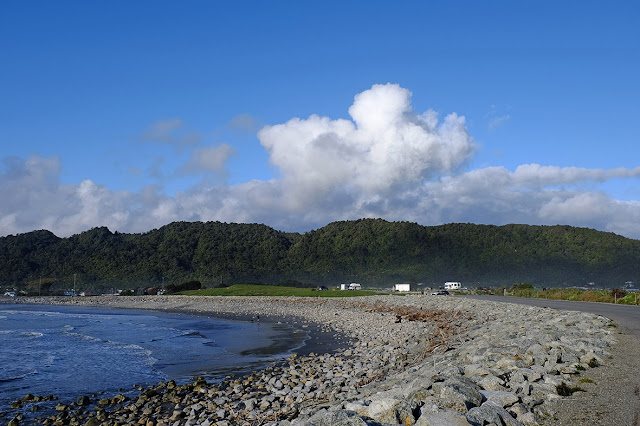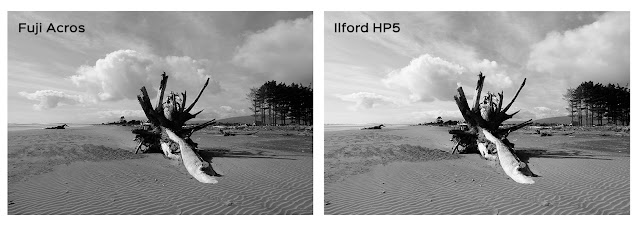In preparation for the 23mm f2
In my last post I outlined my move to a one camera, one lens setup with the Fujifilm X-E2 and Fujinon 23mm f2 prime. It hasn't arrived as yet (any day now), but in preparation for when it does, I thought I would go out in the weekend and shoot around my local beach area using just the 23mm setting on my XC16-50mm zoom lens.
 |
| Cobden Beach Walk. Fujifilm X-E2 with XC16-50mm @ 23mm (35mm fov equivalent) |
I've said before that I'm not really a prime lens kinda guy - preferring the versatility of a zoom lens over the possible limitations of a fixed lens perspective. And yet, over the years - and seemingly as I get older - I've come to realise that the 'bring everything so you don't miss anyhting' attitude is something of a flawed (and expensive) premise. No matter how much you try, it's simply not possible to cover all your bases so that you're always ready for 'the' shot. And yet people will still try to achieve exactly that. I should know, since I've been there and done that myself.
How often have you tried to put a kit together so that you've got every focal length from 16 to 300mm covered in two or three lenses? And then there's the 'superzoom' mentality that says you can have it all with just one lens - something like an 18-300mm f3.5/6.7 or something equally ridiculous! The lens will be horribly distorted at 18mm, and horribly soft at 300mm, but hey, at least you've got all the important focal ranges covered - right?
 |
| Cobden Beach to Point Elizabeth. Fujifilm X-E2 with XC 16-50mm @ 23mm |
Now before you get too irate, yes - I do understand that there are some specific scenarios whereby the one-prime-lens only scenario would not go down too well. I wouldn't do it for a wedding client, for example. Maybe that would require two or three prime lenses (or two zooms) to capture the whole day. Or a sports photographer covering a football match with just a 35mm prime. Probably not a great idea. So I do understand that the whole one lens, one camera ideal isn't for everybody. Heck, it may not even be right for me?
 |
| Monster Buoy. Fujifilm X-E2 with XC16-50mm @ 23mm |
And yet, there is definitely something to the notion of creativity being born from constraint. I firmly believe this is the case in all of the arts. I have argued for many years that if students are given no boundaries or basic skills, and simply told to just 'go and create' with no limits, then any resulting art will be mediocre at best (and perhaps non-existent at worse). When we have everything at our disposal, with no constraints whatsoever, then most of us flounder in a sea of infinite possibilities.
Yet when we are given some clear guidelines or boundaries within which to create, our mind is able to focus more clearly, use those constraints, and come up with creative solutions that form the basis of our art. When you can do absolutely anything, then you'll probably end up with nothing. But if you are 'limited' in a particular way, you can use that limitation to focus your mind and produce something that uses that constraint creatively.
Besides, how much of a constraint is just using a 35mm (fov) for all your photography? Many a travel or documentary photographer would argue that the 35mm prime lens is all they ever need. It is, to coin a much worn phrase, their desert-island lens. Not the 18-300mm superzoom. Not the 10-24mm ultra-wide. And not the 70-200mm telephoto. All nice to have for a certain look - no doubt. But it would be the humble 35mm prime (or equivalent thereof) that they would take with them if push really came to shove.
 |
| Gliding over Cobden Lagoon. Fujifilm X-E2 with XC16-50mm @ 23mm (35mm fov) |
Wandering around my local beach/lagoon walk and just using the 35mm equivalent focal length on my zoom, I definitely felt the constraint of just have a fixed-focal prime lens. There is a family of swans with baby cygnets that are resident in the lagoon at the moment, and I've been following them around with the 50-230mm. Obviously there's no way I'm going to be able to get close to them with a 35mm equivalent focal length, so as stated earlier, I guess it's not a wildlife lens. Then again, I'm not a wildlife photographer. But it's just one example of having to be aware of a focal lengths 'limitations' and not being disappointed that it can't achieve a result it was never designed for.
What it was designed for was as a general, all-purpose lens in the lightly wide to normal focal length range. Usable for landscapes, usable for environmental portraits, and usable as an all-purpose travel/documentary lens. It's not a sports/action/wildlife lens, and trying to use it as such will largely end in frustration.I say 'largely' because contrary to what I've just said, it can be used as a sports lens, especially if you are focusing more on the documentary end of sports photography.
I guess what I'm trying to say is 'horses for courses' and if you decide to use only one prime focal length, you need to make peace with the images that you won't be able to take, as much as with the ones that you will.
As my wife and I walked around the beach and lagoon on a sunny afternoon, just snapping away at whatever caught me eye, it was highly unlikely that I was going to get stunning photos. They are what they are - snapshots taken on a walk in the middle of the afternoon. I don't think they would have been any better, or any worse, if I had been able to zoom around with my 16-50mm lens. Different maybe - but probably no better.
I actually missed the best photo opportunity because I didn't have the confidence to take the shot. And the 35mm focal length would have been perfect for it. As my wife and I were walking along the lagoon, a woman on a horse came slowly riding towards us. It would have made a great image, if I had have plucked up the courage to ask if I could take her photo. But I didn't. and I missed the opportunity. Missing the shot in this instance had nothing to do with my camera or lens, but with me as the photographer. How often is that the case?
Am I trying to talk myself into this whole one lens, one camera philosophy? Maybe - a little bit. When I first got excited about this 'minimalist' approach, I thought I would sell both my zoom lenses and only own one prime. Nothing else. My wife suggested I might want to re-think that position and actually hold on to them instead (she's a wise woman). I think that's sound advice, so I'll be holding on to the XC16-50mm and XC50-230mm in the meantime.
Part of me can see the sense in this approach, and then another part of me thinks that it's just admitting defeat before giving it a decent shot? Is cold turkey the way to go with this one lens, one camera philosophy? Dunno. I guess time will tell...




Comments
Post a Comment